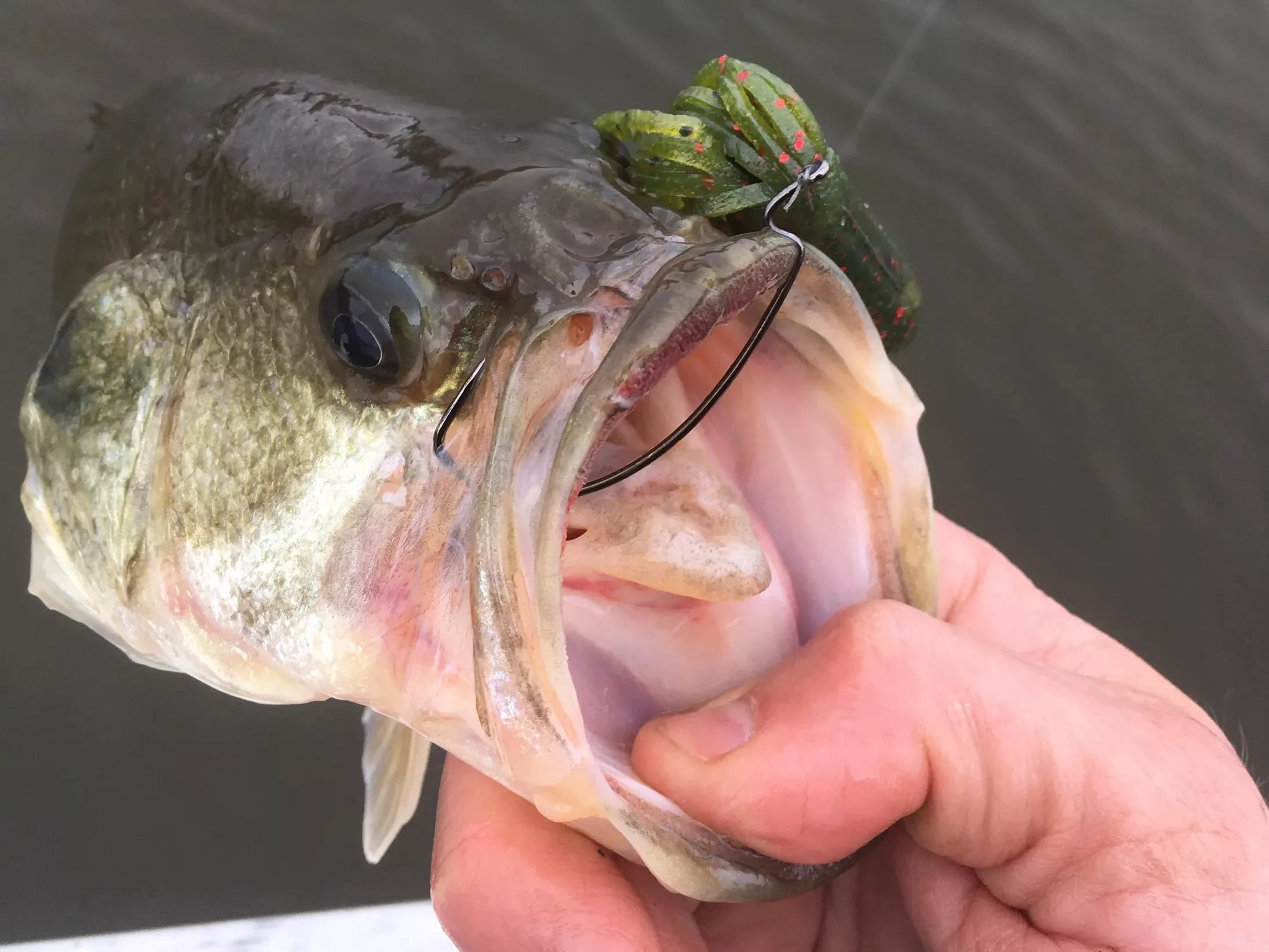
All Clear! A well-positioned plastic will slide up and out of the way when setting the hook on a bass. Make sure that knots are properly positioned at the top of the hook eye, baits rest loosely in place when threaded onto a hook, and that weights don’t get in the way when bass bite and more fishing success can be had with these options. Simonson Photo.
By Nick Simonson
Summertime means working soft plastics for both largemouth and smallmouth bass, and more often than not those lures are offered up on a wide gap worm hook. While this is often the best way to present plastic options, these hooks require a mastery of both their advantages and their shortcomings. It’s the latter that can confound new bass anglers, or those unfamiliar with them. What follows are three quick caveats for using worm hooks with soft plastics and how to address them to catch more fish and limit frustration with this ubiquitous bit of bass tackle.
Mind the Gap
As with just about any hook, the eye on a worm hook is not a solid circle, but rather a bend where the main portion of the shank and the end of the wire meet. Outside of jigs, where a lead head and paint meet, sealing off the eye in a solid manner, most hooks employed on their own for bass have this small but significant shortcoming. In the era of coated superlines that can compress and slide through the tiniest of spaces, the small point where wire and main hook connect can result in lost fish, especially on a hard hookset which is often required when powering the point through a plastic and into a bass’s mouth.
There are a few ways around this slight inconvenience. The easiest is by checking where the knot is aligned on the hook eye before each cast. Making certain it is not lodged in this small space will help prevent it from sliding through on the hookset. The second option is to tie a thick knot, such as a double Palomar knot to prevent the line from sliding through. Finally, prior to use, the hook eye can be epoxied creating a bond that seals the small opening, and then the epoxy in the eye can be removed with a toothpick before hardening or hook eye cleaner after it cures. All of these options will prevent line from sneaking through the gap and losing both a fish and a lure in the process of a strong hookset.
Bunches of Trouble
The angled nature of a worm hook, especially those with wider gaps, can cause bass baits to bunch up near the hook point, instead of sliding up the line on the hookset and ending up out of the way as they should. In order to prevent the dreaded “tube bunch” as it’s often referred to, make sure that the soft lure being used matches the size of the hook and that the plastic is properly positioned on it when rigged.
For tubes of three to four inches in length, a 2/0 wide gap worm hook will do the trick. For larger tubes or longer soft plastic sticks and creature baits, hooks up to 5/0 can be used. Just make sure the bait is not being stretched to fit on the hook; it should lie in its standard form and be fairly supple to the touch, not taught. If the bait continues to snake its way back down the hook after each cast, or bunches up on a hookset, try using a smaller hook.
Additionally, when threading a shorter tube on a smaller hook, don’t go as deep into the plastic when making the first turn in a standard Texas rig. Instead, insert the point into the tip of the tube and then quickly turn it back out through the plastic, as opposed to threading it down into the tube’s body. With larger soft plastics that are more solid, it’s not as much of an issue, but for shorter, hollow bass offerings doing so will help the bait position better on the hook and slide up the line when a bass bites.
Weight Watcher
Finally, whether or not a weight is employed on a bass lure can impact performance of the plastic and the hook. While there are a number of options available, the choice often comes down to loose bullet weights, pegged bullet weights and pinch on bullet weights. On loose bullet weights, the lead moves freely up and down the line. It may impact some casts and skipping applications, but it slides freely up the line on the hookset without any issues. For pegged bullet weights held in place by a small stop or the tip of a broken toothpick, the lead only moves on a hard hookset. This may prevent some lure movement off of the worm hook, but does allow for some slide.
Finally, for those bass anglers preferring pinch on weights, these options may limit lure movement and proper hook sets. When using these options, there may be a channel in the pinch on weight that allows for some slide. Inspect each one and see if it is able to move somewhat freely up the line for the best possible performance, noting that the tradeoff for convenience may be limited mobility.
By managing these three aspects of worm hook use, their strong suits can be accented and more bass can be caught. Keep a watch on where line is located in the hook eye on each cast, position each bait properly on a hook that matches the size of the soft plastic, and manage weight usage accordingly to get the most out of each offering. By doing so, angling with one of bass fishing’s most popular and effective otions can become a breeze and angling skills can be advanced into a multitude of new presentation styles.
Simonson is the lead writer and editor of Dakota Edge Outdoors.
